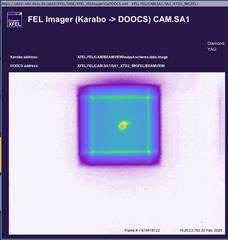URL: https://www.desy.de/news/news_search/index_eng.html
Breadcrumb Navigation
DESY News: European XFEL reaches world record photon energies
News
News from the DESY research centre
European XFEL reaches world record photon energies
The availability of femtosecond pulses of hard X-rays at light source facilities such as European XFEL, opens up unprecedented scientific opportunities to probe matter and materials at the atomic scale at ultra-short timescales. With its unique capability to generate intense X-ray pulses at energies of 25 keV and beyond, the European XFEL is the only X-ray free-electron laser worldwide to enable the possibility to delve into unchartered worlds and study complex phenomena like never before.
With a photon energy of 25 kilo-electronvolts (keV), corresponding to a laser wavelength of 0.5 Angstroms (0.05 nanometres), DESY´s operations team of the European XFEL accelerator set a new wavelength record for laser light. But that was not all - by changing the setting of the undulator SASE1, one of the light generation devices of European XFEL, to 30 keV the accelerator team was able to push the limit even further, observing clear indications of free-electron laser radiation on a scintillating screen.“The photon energy of 25 keV surpasses the original design photon energy of European XFEL by a factor of two and marks the far end of the anticipated design envelope,” says Winfried Decking, head of DESY´s European XFEL accelerator team. “This result is not yet transferable for user operation, but demonstrates the unique capabilities of the European XFEL in combining a high energy linac and the about 230-metres-long flexible undulator systems.”
“It is exciting to see that the European XFEL is capable of achieving these photon energies” says Sakura Pascarelli, scientific director at European XFEL. “Since high energy X-rays allow for larger penetration depths, this will enable the investigation of materials in complex, highly absorbing, environments. These parameters will be crucial for studying, for example, dynamic processes in material science and engineering, the structure and dynamics of liquids, melts and solutions, and the investigation of matter at very high pressure in diamond anvil cells.”
After the winter shutdown 2019/2020 the accelerator experts from DESY focused on re-establishing the high electron energies that had been reached already in 2018. With the help of the so-called piezo tuners, devices that mechanically deform each of the 800 superconducting cavities ten times per second to counteract the shape variation that is inflicted by the electromagnetic forces of the pulsed RF field, the frequencies of the cavities could be kept constant at a so far unreached accuracy. This allowed for stable operation at an electron energy of 17.5 GeV for many hours and with the full design number of bunches.
Given the high electron energies, scientists immediately tested the photon energy boundaries of the facility. By setting the SASE1 undulator gaps accordingly, lasing at the world record energy of 25 keV could be observed with an energy measured to be around 100 μJ per X-ray pulse. The photon diagnostic operates at the edge of its present measurement range at this point. A first user experiment with the accelerator operating at 16.5 GeV and at photon energy of 24 keV has been planned at the SASE2 undulator for 2020. The recently reached results at SASE1 are a crucial step towards realizing these experiments once the facility is back to full performance from the safe state it is currently in due to the SARS-CoV-2 pandemic.




